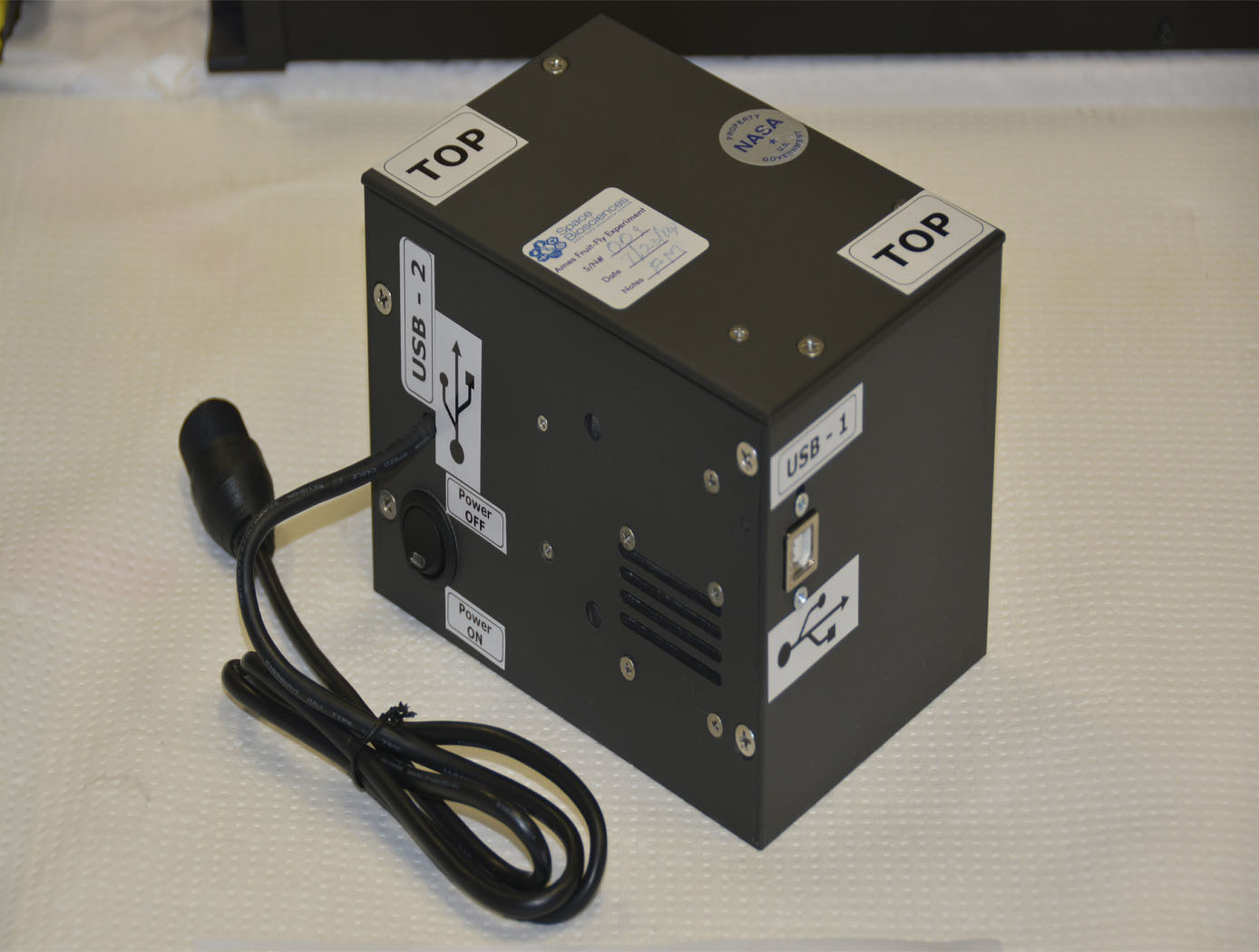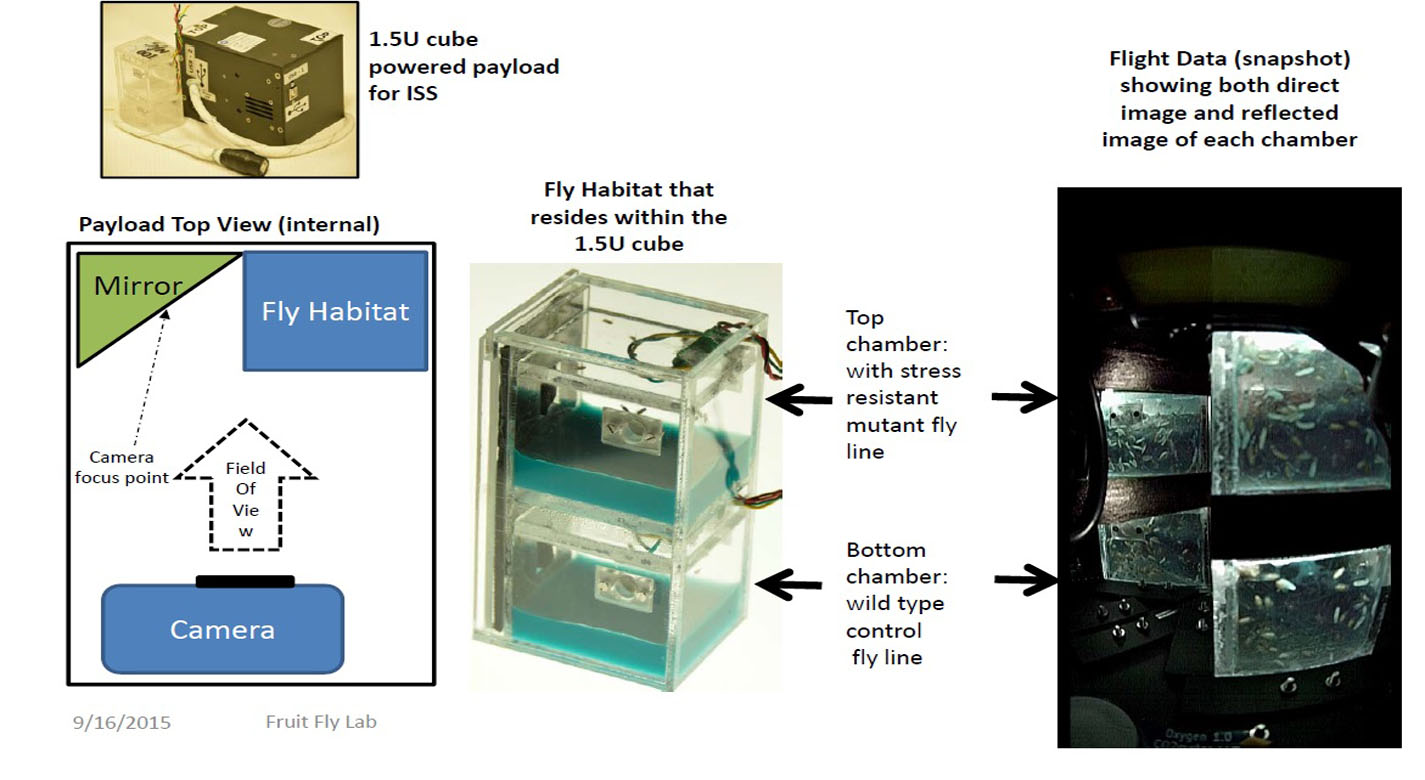Compact Science Experiment Module
robotics automation and control
Compact Science Experiment Module (TOP2-270)
A compact modular enclosure for performing science experiments in space and on the ground
Overview
Crew time on the International Space Station (ISS) is extremely limited for any operations on science payloads. Autonomous science experiments in small self-contained cubical payloads are highly desirable because these payloads take up minimal space and spaceflight resources. The Compact Science Experiment Module (CSEM) was originally designed as a plug-and-play science experiment to study the activity of fruit flies in microgravity. It is comprised of a compact modular enclosure with a transparent habitat, camera with mirror to monitor two dimensions simultaneously, microcontroller for controlling the experiment, LED lighting for creating circadian effects, and various sensors to monitor that the environment stays healthy for the organism under study. The CSEM can be modified to study other organisms such as plants and small scale non-life science experiments. Powered through the USB cable, the CSEM can also connect to ISS telemetry for data transmission to the ground. The astronaut can simply plug in the USB cable to start the experiment.
The Technology
The Compact Science Experiment Module (CSEM) provides a suitable experiment platform consisting of an enclosure that contains all the required components to perform science experiments that can house either living biological samples or other samples on both the ground and on the International Space Station (ISS). The invention provides required instrumentation for video capture and data storage, environmental monitoring, inclusive of sensing temperature in degree Celsius, relative humidity as a percentage, carbon dioxide in parts per million and oxygen in percentage format. Data can be stored within the module and retrieved after the experiment or can be transmitted to the ground as for example from the ISS, by connecting to the ISS telemetry system.
The Compact Life Science Experiment Module has been fully developed at NASA Ames Research Center and tested on the ISS. In general, fruit fly studies can provide information about the effects of spaceflight at the biochemical, cellular and organismal levels. Using fruit fly spaceflight hardware, researchers are able to investigate the role of spaceflight on development, growth, reproduction, aging, neurobehavioral responses, immunity, heart function, etc. The fruit fly genome matches the human disease genome by almost 77%, and flies have, therefore, been a useful tool for scientists to understand the genetics, and molecular biology of more complex biological systems like humans. The Compact Science Experiment Module is extremely adaptable to other model specimens and samples as well, and has also flown plant experiments on the ISS. The software can be tailored to accommodate different experiment scenarios by adjusting video imaging times, LED light cycles, data storage and telemetry etc.


Benefits
- Autonomous (plug and play) requires little crew time
- Rugged and modular fits in standard rack on the ISS
- Small and lightweight
- Powered by the USB cable
- Customizable for each science experiment
- Science data can be stored and transmitted from ISS racks
Applications
- Space applications on the ISS: Small scale science experiments in: Biology Plant growth Drug efficacy Environmental gas sensing/contaminants Physics Materials science
- Ground applications: Ground-based experiment controls for the above applications Remote experiments through wireless transmission
Similar Results

Portable Microscope
The handheld digital microscope features a 3D-printed chassis to house its hardware, firmware, and rechargeable Li-ion battery with built-in power management. It incorporates an internal stainless-steel cage system to enclose and provide mechanical rigidity for the optics and imaging sensor. To reduce the microscope’s size, yet retain high spatial resolution, engineers devised an optical light path that uniquely folds back on itself using high reflectivity mirrors, thus significantly reducing internal volume.
Imaging control and acquisition is performed using a secure web-based graphical user interface accessible via any wireless enabled device. The microscope serves as its own wireless access point thus obviating the need for a pre-existing network. This web interface enables multiple simultaneous connections and facilitates data sharing with clinicians, scientists, or other personnel as needed. Acquired images can be stored locally on the microscope server or on a removable SD card. Data can be securely downloaded to other devices using a range of industry standard protocols.
Although the handheld digital microscope was originally developed for in-flight medical diagnosis in microgravity applications, prototypes were thoroughly ground-tested in a variety of environments to verify the accurate resolve of microbial samples for identification and compo-sitional analysis for terrestrial field use. Owing to its portability, other applications demanding rapid results may include research, education, veterinarian, military, contagion disaster response, telemedicine, and point-of-care medicine.

Full-Size Reduced Gravity Simulator For Humans, Robots, and Test Objects
The Active Response Gravity Offload System (ARGOS) provides a simulated reduced gravity environment that responds to human-imparted forces. System capabilities range from full gravity to microgravity. The system utilizes input/feedback sensors, fast-response motor controllers, and custom-developed software algorithms to provide a constant force offload that simulates reduced gravity.
The ARGOS system attaches to a human subject in a gimbal and/or harness through a cable. The system then maintains a constant offload of a portion of the subjects weight through the cable to simulate reduced gravity. The system supports movements in all 3 dimensions consistent with the selected gravity level. Front/back and left/right movements are supported via a trolley on an overhead runway and bridge drive system, and up/down movements are supported via a precisely positioned cable. The system runs at a very high cycle rate, and constantly receives feedback to ensure the human subjects safety.

Micro-Organ Device Mimics Organ Structures for Lab Testing
The MOD platform technology represents a small, lightweight, and reproducible in vitro drug screening model that could inexpensively mimic different mammalian tissues for a multitude of applications. The technology is automated and imposes minimal demands for resources (power, analytes, and fluids). The MOD technology uses titanium isopropoxide to bond a microscale support to a substrate and uses biopatterning and 3D tissue bioprinting on a microfluidic microchip to eliminate variations in local seeding density while minimizing selection pressure. With the MOD, pharmaceutical companies can test more candidates and concentrate on those with more promise therefore, reducing R&D overall cost.
This innovation overcomes major disadvantages of conventional in vitro and in vivo experimentation for purposes of investigating effects of medicines, toxins, and possibly other foreign substances. For example, the MOD platform technology could host life-like miniature assemblies of human cells and the effects observed in tests performed could potentially be extrapolated more readily to humans than could effects observed in conventional in vivo cell cultures, making it possible to reduce or eliminate experimentation on animals.
The automated NASA developed technology with minimal footprint and power requirements, micro-volumes of fluids and waste, high throughput and parallel analyses on the same chip, could advance the research and development for new drugs and materials.

Low Weight Flight Controller Design
Increasing demand for smaller UAVs (e.g., sometimes with wingspans on the order of six inches and weighing less than one pound) generated a need for much smaller flight and sensing equipment. NASA Langley's new sensing and flight control system for small UAVs includes both an active flight control board and an avionics sensor board. Together, these compare the status of the UAVs position, heading, and orientation with the pre-programmed data to determine and apply the flight control inputs needed to maintain the desired course.
To satisfy the small form-factor system requirements, micro-electro-mechanical systems (MEMS) are used to realize the various flight control sensing devices. MEMS-based devices are commercially available single-chip devices that lend themselves to easy integration onto a circuit board. The system uses less energy than current systems, allowing solar panels planted on the vehicle to generate the systems power. While the lightweight technology was designed for smaller UAVs, the sensors could be distributed throughout larger UAVs, depending on the application.

Automata Learning in Generation of Scenario-Based Requirements in System Development
In addition, the higher the level of abstraction that developers can work from, as is afforded through the use of scenarios to describe system behavior, the less likely that a mismatch will occur between requirements and implementation and the more likely that the system can be validated. Working from a higher level of abstraction also provides that errors in the system are more easily caught, since developers can more easily see the big picture of the system.
This technology is a technique for fully tractable code generation from requirements, which has an application in other areas such as generation and verification of scripts and procedures, generation and verification of policies for autonomic systems, and may have future applications in the areas of security and software safety. The approach accepts requirements expressed as a set of scenarios and converts them to a process based description. The more complete the set of scenarios, the better the quality of the process based description that is generated. The proposed technology using automata learning to generate possible additional scenarios can be useful in completing the description of the requirements.



